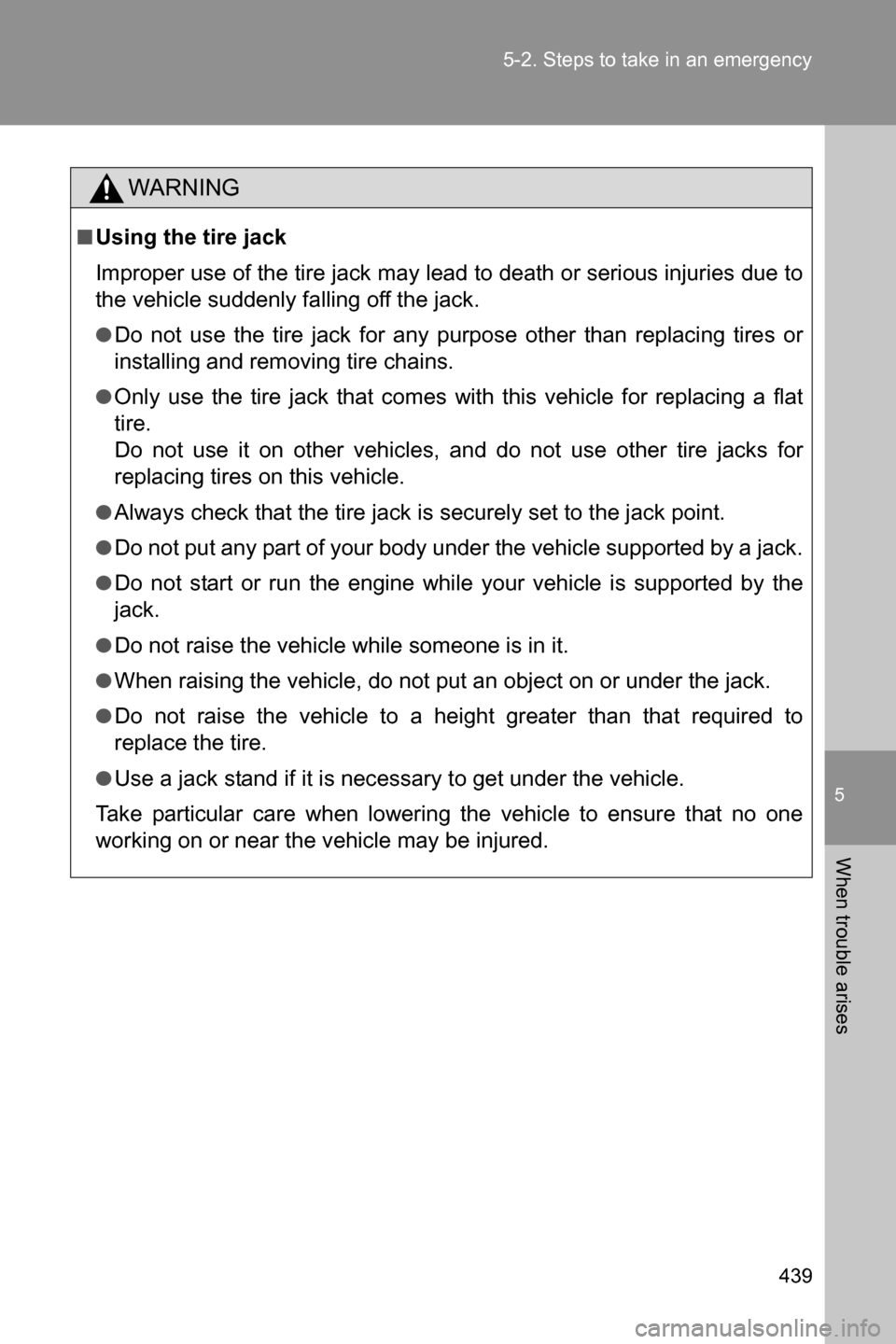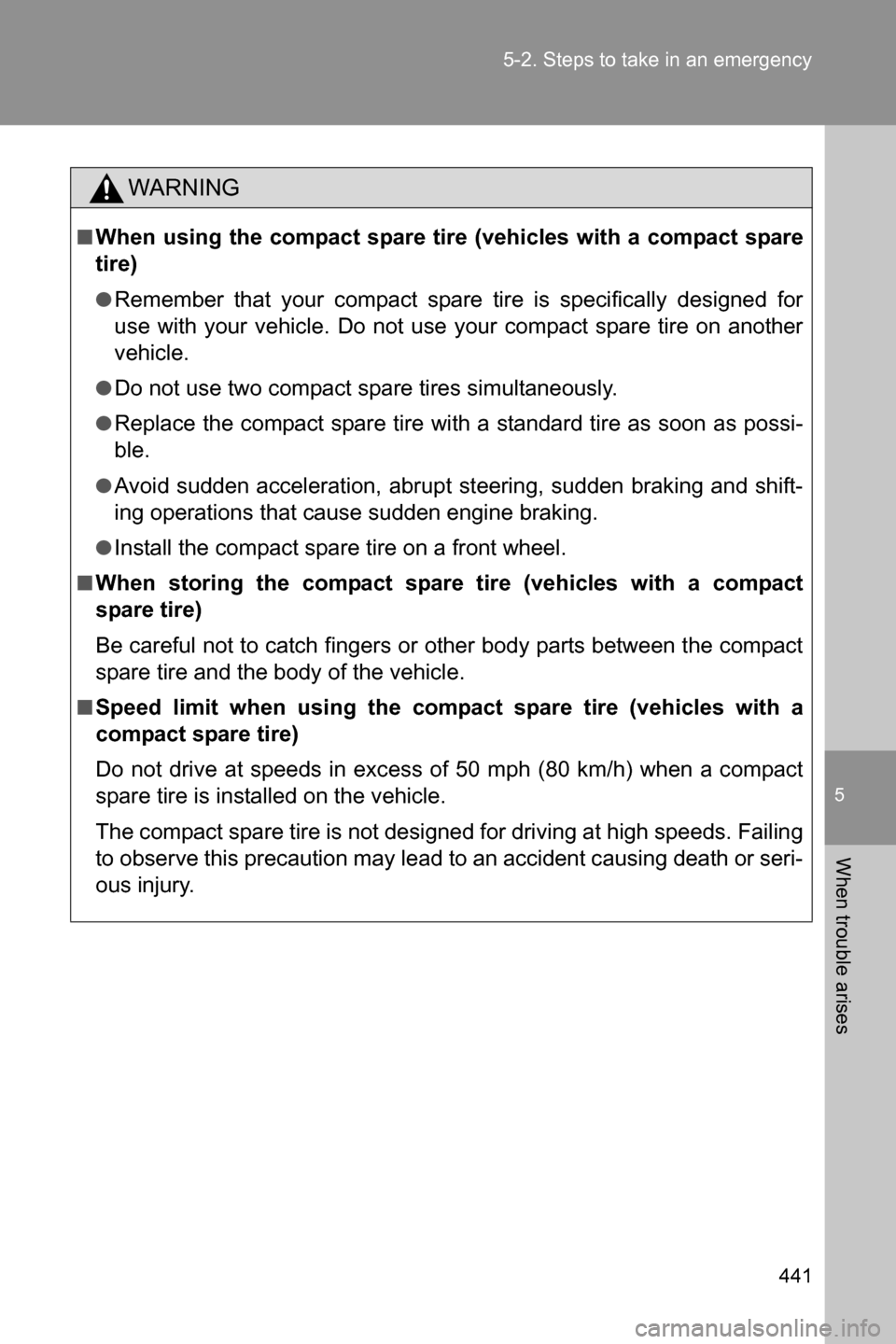Page 435 of 540
5
When trouble arises
433 5-2. Steps to take in an emergency
Taking out the spare tire
Vehicles with a compact spare tire
Remove the luggage mat.
Remove the cover and loosen
the center fastener that secures
the spare tire.
Vehicles with a spare tire of the same wheel type as the installed
tires
Loosen the center fastener that
secures the spare tire.
STEP 1
STEP 2
Page 436 of 540
434 5-2. Steps to take in an emergency
Replacing a flat tire
Chock the tires.
STEP 1
Flat tire
Wheel
chock posi-
tions
FrontLeft-
hand
sideBehind the
rear right-
hand side
tire
Right-
hand
sideBehind the
rear left-
hand side
tire
RearLeft-
hand
sideIn front of
the front
right-hand
side tire
Right-
hand
sideIn front of
the front
left-hand
side tire
Page 438 of 540
436 5-2. Steps to take in an emergency
Installing the spare tire
Remove any dirt or foreign mat-
ter from the wheel contact sur-
face.
If foreign matter is on the wheel
contact surface, the wheel nuts
may loosen while the vehicle is
in motion, and the tire may
come off the vehicle.
Install the spare tire and loosely tighten each wheel nut by
hand to approximately the same amount.
Vehicles with a compact spare
tire: Tighten the wheel nuts until
the tapered portion comes into
loose contact with the disc wheel
seat.
Vehicles with a spare tire of the
same wheel type as the installed
tires: Tighten the wheel nuts until
the tapered portion comes into
loose contact with the disc
wheel.
STEP 1
STEP 2
Tapered portion
Disc wheel
seat
Disc
wheel
Tapered portion
Page 441 of 540

5
When trouble arises
439 5-2. Steps to take in an emergency
WARNING
■Using the tire jack
Improper use of the tire jack may lead to death or serious injuries due to
the vehicle suddenly falling off the jack.
●Do not use the tire jack for any purpose other than replacing tires or
installing and removing tire chains.
●Only use the tire jack that comes with this vehicle for replacing a flat
tire.
Do not use it on other vehicles, and do not use other tire jacks for
replacing tires on this vehicle.
●Always check that the tire jack is securely set to the jack point.
●Do not put any part of your body under the vehicle supported by a jack.
●Do not start or run the engine while your vehicle is supported by the
jack.
●Do not raise the vehicle while someone is in it.
●When raising the vehicle, do not put an object on or under the jack.
●Do not raise the vehicle to a height greater than that required to
replace the tire.
●Use a jack stand if it is necessary to get under the vehicle.
Take particular care when lowering the vehicle to ensure that no one
working on or near the vehicle may be injured.
Page 443 of 540

5
When trouble arises
441 5-2. Steps to take in an emergency
WARNING
■When using the compact spare tire (vehicles with a compact spare
tire)
●Remember that your compact spare tire is specifically designed for
use with your vehicle. Do not use your compact spare tire on another
vehicle.
●Do not use two compact spare tires simultaneously.
●Replace the compact spare tire with a standard tire as soon as possi-
ble.
●Avoid sudden acceleration, abrupt steering, sudden braking and shift-
ing operations that cause sudden engine braking.
●Install the compact spare tire on a front wheel.
■When storing the compact spare tire (vehicles with a compact
spare tire)
Be careful not to catch fingers or other body parts between the compact
spare tire and the body of the vehicle.
■Speed limit when using the compact spare tire (vehicles with a
compact spare tire)
Do not drive at speeds in excess of 50 mph (80 km/h) when a compact
spare tire is installed on the vehicle.
The compact spare tire is not designed for driving at high speeds. Failing
to observe this precaution may lead to an accident causing death or seri-
ous injury.
Page 445 of 540

5
When trouble arises
443 5-2. Steps to take in an emergency
CAUTION
■Do not drive the vehicle with a flat tire.
Do not continue driving with a flat tire.
Driving even a short distance with a flat tire can damage the tire and the
wheel beyond repair.
■Be careful when driving over bumps with the compact spare tire
installed on the vehicle (vehicles with a compact spare tire).
The vehicle becomes lower when driving with the compact spare tire
compared to when driving with standard tires. Be careful when driving
over uneven road surfaces.
■Driving with tire chains and the compact spare tire (vehicles with a
compact spare tire)
Do not fit tire chains to the compact spare tire.
Tire chains may damage the vehicle body and adversely affect driving
performance.
■When replacing the tires (vehicles with a tire pressure monitoring
system)
When removing or fitting the wheels, tires or the tire pressure warning
valve and transmitter, contact your SUBARU dealer as the tire pressure
warning valve and transmitter may be damaged if not handled correctly.
■To avoid damage to the tire pressure warning valves and transmit-
ters (vehicles with a tire pressure monitoring system)
When a tire is repaired with liquid sealants, the tire pressure warning
valve and transmitter may not operate properly. If a liquid sealant is
used, contact your SUBARU dealer or other qualified service shop as
soon as possible. Make sure to replace the tire pressure warning valve
and transmitter when replacing the tire. (�oP. 3 5 1 )
■Stowing the jack
When stowing the jack in the jack holder, make sure that the part that the
jack handle attaches to is pointing towards the inside of the trunk. Failure
to do so may damage the vehicle body.
Page 463 of 540
5
When trouble arises
461
5-2. Steps to take in an emergency
If the vehicle becomes stuck
■When it is difficult to free the vehicle Carry out the following procedures if the tires spin or the vehicle
becomes stuck in mud, dirt, or snow:
Stop the engine. Set the parking brake and shift the select
lever to P (vehicles with an automatic transmission) or shift
lever to neutral (vehicles with a manual transmission).
Remove the mud, snow or sand from around the rear
wheels.
Place wood, stones or some other material under the rear
wheels to help provide traction.
Restart the engine.
Shift the select lever to the D or R position (vehicles with an
automatic transmission) or shift lever to 1 or R position
(vehicles with a manual transmission) and release the park-
ing brake. Then, while exercising caution, depress the
accelerator pedal.STEP 1
STEP 2
STEP 3
STEP 4
STEP 5
Press to turn off TRAC. (�oP. 252)
Page 476 of 540
474 6-1. Specifications
Steering
Tires and wheels (for vehicles sold in the U.S.A. and Canada)
Free play Less than 1.2 in. (30 mm)
Tire size 215/45R17 87W, T135/80D16 101M
Tire inflation pressure
(Recommended cold tire
inflation pressure)Front
35 psi (240 kPa, 2.4 kgf/cm2 or bar)
Rear
35 psi (240 kPa, 2.4 kgf/cm
2 or bar)
Spare
60 psi (420 kPa, 4.2 kgf/cm
2 or bar)
Wheel size 17 �u 7 J, 16 �u 4T (spare)
Wheel nut torque89 ft•lbf (120 N•m, 12.2 kgf•m)